A hands-on look at accessibility on buses
A hands-on look at accessibility on buses
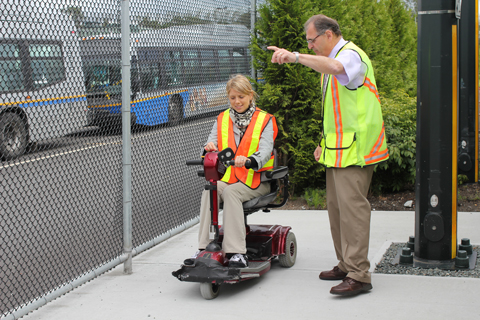
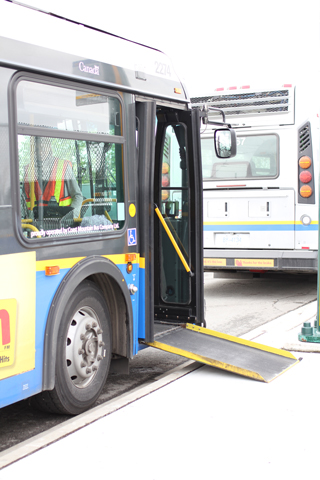
So, as Access Awareness Day is on Saturday June 5, I went to learn about accessibility on buses with Coast Mountain Bus Company’s training department last week!
Julie from Access Transit joined me at Vancouver Transit Centre, our main Vancouver bus depot. Bert from training had set up a trolley and a new diesel bus to show us the accessibility training provided to both operators and passengers. There’s a curb and a bus stop in the yard to simulate real-world conditions!
By the way, did you know that passengers with disabilities can book appointments with our training department to practice entering and exiting buses in the yard? Patients from the G.F. Strong Rehabilitation Centre often come down to give it a try, if they’re not used to riding public transit with an assistive device yet.
(To book an appointment, call Ron Williams at 604-264-5420 to set up a time! The training department will arrange to have buses ready so you can practice for as long as you need to feel comfortable.)
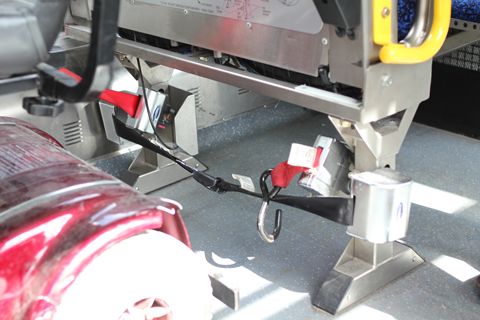
Every transit vehicle in the TransLink fleet is accessible to wheelchairs and scooters: buses can kneel to meet the sidewalk, and can lower ramps to assist people with boarding. As such, all operators are given accessibility training, and they learn how to work the ramp and secure passengers in the vehicle.
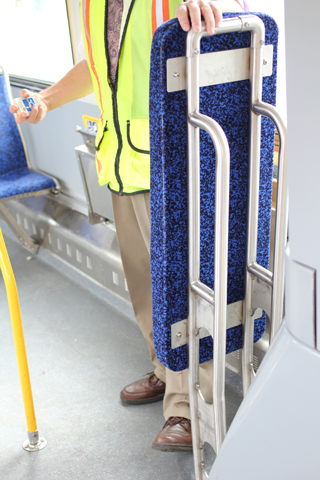
We learned, however, that you only need to secure a person’s scooter or wheelchair using straps if they are parked facing forward on the right hand side of the bus. If a passenger parks against the big padded rectangle behind the driver’s seat, no straps are needed. (The seatbelt is optional unless you’re under 16—then you are required to use the seatbelt.)
Low-floor ramps can be manually lowered if the lift mechanism isn’t working, by the way! The old high-floor ramps were notoriously temperamental and not useful once on the fritz: this post for more.
Oh yes — operators also undergo sensitivity training on the day before they graduate. Rob Sleath and a few other folks come in and give a seminar, which includes real-life examples where operators are blindfolded and asked to try to board the bus.
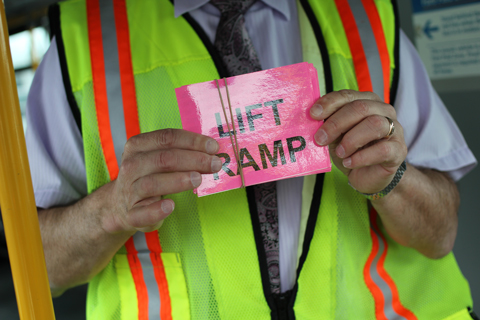
For passengers with disabilities, the training department offers a number of useful cards in case they might be handy. The flash card showing “Lift Ramp” is provided in case customers want to show it to the driver before they board. Bert said the cards aren’t always used, but they are available just in case.
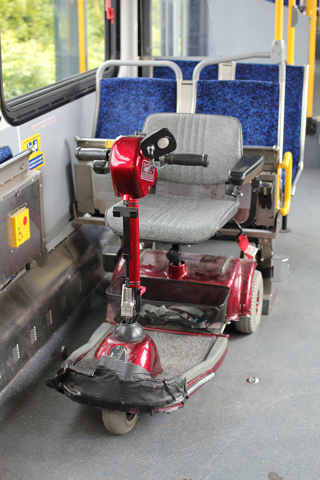
The training department has a scooter and a wheelchair on hand so that operators can practice handling real assistive devices. The scooter is nicknamed is Dave after one of the trainers, and Bert pointed out that the front was wrapped in tape because it has been quite beat up after all of these years. And we soon found out why!
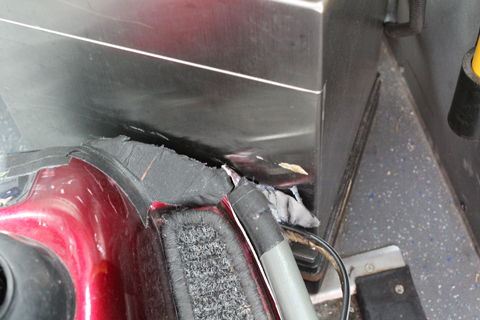
Both Julie and I tried boarding the trolley using the scooter—and discovered it was a lot more challenging than you might think!
For example, when I tried to board, I ran straight into the farebox! I’d never realized the farebox was such a formidable obstacle: no wonder there was a lot of tape on the poor scooter. Bert said getting past the farebox is why four-wheeled scooters can’t get on the bus: they’re just too big to get by!
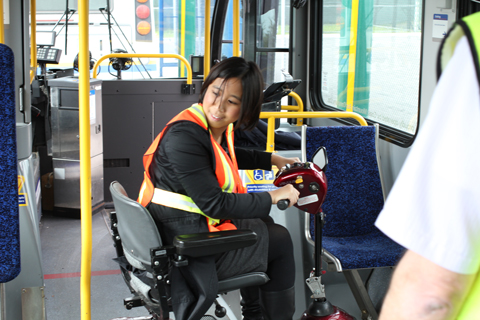
As well, once inside, maneuvering the scooter into the right position also took work. It’s really, really clear why some passengers want to practice this on their own instead of boarding a bus when it’s busy.
I tried parking in the right-hand space, and it turned out to require a three-point turn to get there. There were numerous crashes into the pole, and a lot of thanks that no one else was sitting on the bus, as I would have hit all of them.
Then, driving into the space behind the driver was a lot like parallel parking: you had to go forward, then reverse at an angle into the space. Essentially, for the uninitiated, it’s a real feat to navigate the front area quickly and get into position so the bus can take off. I kept thinking I was taking forever to get into place, even though my boarding time was about 90 seconds: if other passengers were on board, their patience would have been much appreciated!
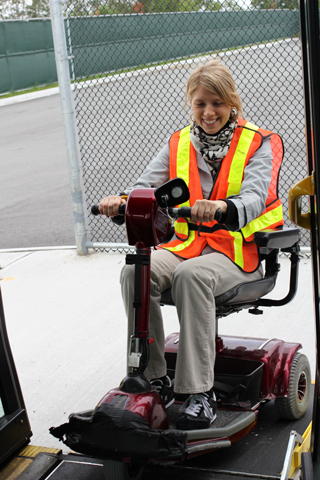
Julie and I both tried boarding the diesel bus in the scooter too. It turned out to have a much wider entrance than the trolley bus (who knew?) and was very easy to board!
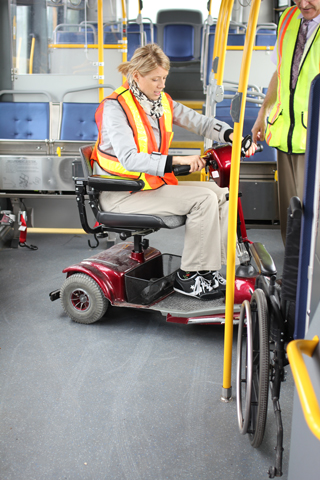
There was a manual wheelchair on the bus, and we put it in the space behind the driver while Julie tried to park the scooter on the right side. The wheelchair greatly reduced the amount of room to maneuver — although Julie did handle parking like a pro, it must be said!
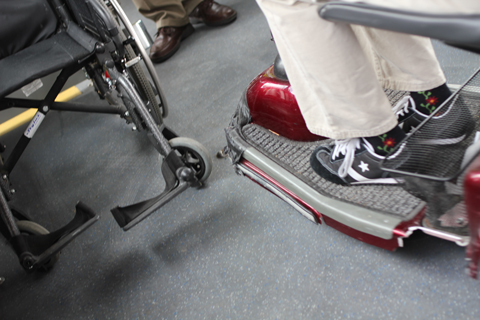
There were, however, some really close calls in parking. We got very, very close to the wheelchair when trying to park — if someone had really been in it, they could have been hit! It also makes you more conscious of getting out of the way if a passenger in a scooter or wheelchair is trying to park: any extra room to maneuver must certainly help them out.
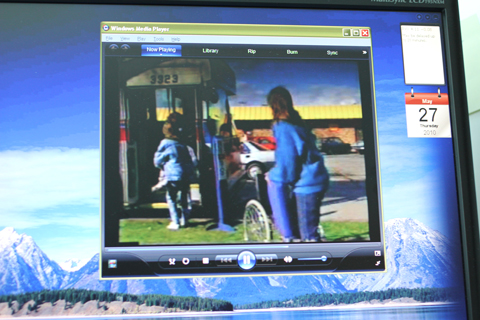
That was the end of the hands-on practice. At the end of the trip, Ron from the training department kindly showed us some of the older training videos that used to be standard material. The 1987 video “Seeing It Their Way” was quite an eye opener: the older buses had steps and a pole in the middle of the entrance, blocking easy access into the bus. And as seen in the photo above, there was a short clip showing how a person in a wheelchair could be taken onto the bus: his friends lifted him out and carried him on, while another friend folded up the wheelchair and took it on board. A lot has changed!






Ahh… so that’s what the rectangular pad is for… Up until now, I was always thinking of it as taking up a potential seat space because the older D40LF and D60LF seem (to me) to do fine without it. One strange thing is the one E40LF designated trolleybus, not E40LFR, has the pad on the passenger side of the bus. And talking about parking the scooters, sometimes I see this lady on the 16 and she can park her scooter in one go. Really pro! And about the pole in the middle of the doors, I saw the Mendoza trolleybus blog and it turns out that they took out the pole that was in the middle of the back doors and put a wheelchair lift there.
2101, the first new trolley bus, does indeed have a slightly different seating arrangement.
After input was received, the “ironing board” i.e. rear-facing securement location was switched to the left side for several reasons, among them so as not to block the visibility out the front window. People needed to see where they were going so they knew when to get off!
And the farebox being in the way for 4 wheeled scooters makes me thankful that my scooter can go 40 miles on a charge thus when combined with skytrain and streetview to check for sidewalks/curbcuts/potential obstacles, I can get pretty much anywhere in Vancouver/Richmond/Burnaby/New West and significant portions of North Van/Coquitlam/Surrey.
And yes, parking/maneuvering a scooter is a lot harder than it looks, just most of us make it look easy.
PS: The CVG urban trail is wonderful, I can get from my place in Burnaby to English Bay for the fireworks in 90 minutes.
Is there a hand brake that can allow you to pull a U-turn and “drift” into that spot? Perhaps this should be part of the rodeo competition.
[…] […]